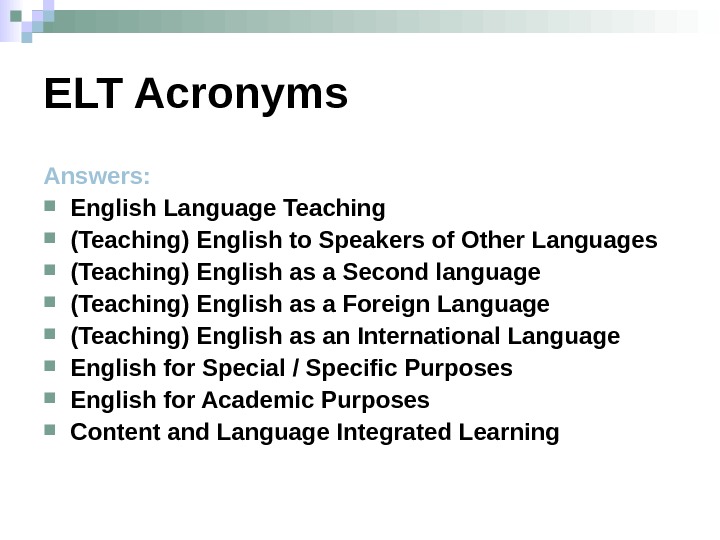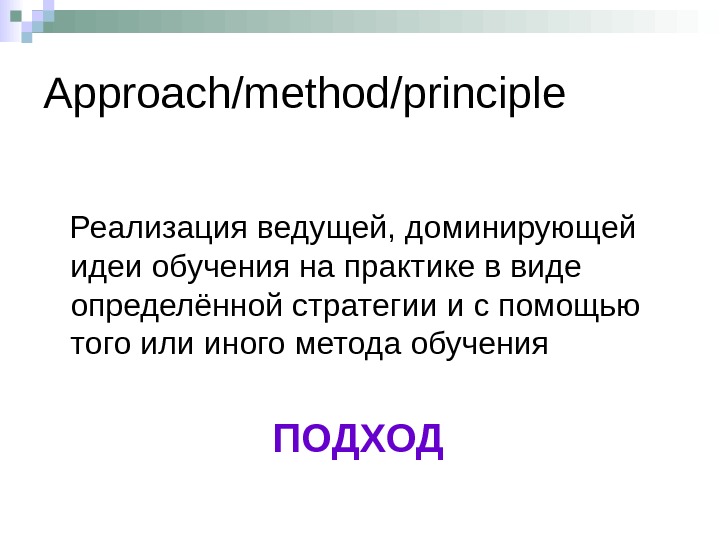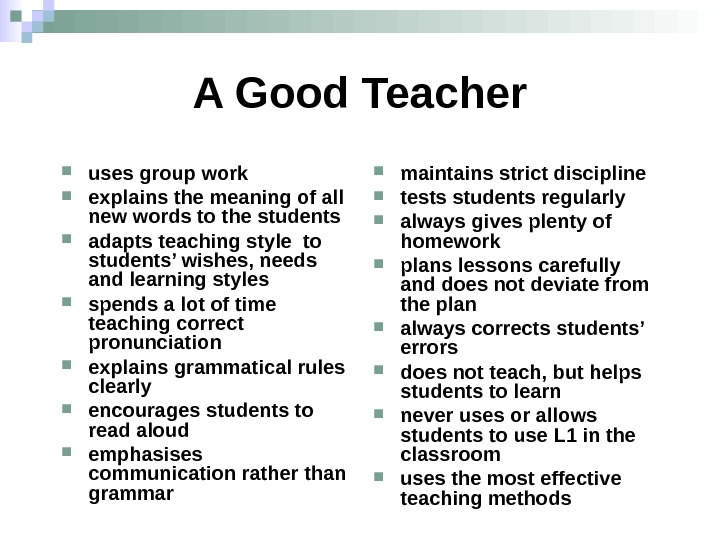Презентация methods and approaches 1


























- Размер: 237.5 Кб
- Количество слайдов: 25
Описание презентации Презентация methods and approaches 1 по слайдам
 CURRENTS OF CHANGE An Overview of Terminology and Methodology in English Language Teaching
CURRENTS OF CHANGE An Overview of Terminology and Methodology in English Language Teaching
 Дополните предложения : Я думаю, что _________подход является наиболее современным. Наиболее распространённый методом сейчас является_________. В своей работе я всегда руководствуюсь принципом_____.
Дополните предложения : Я думаю, что _________подход является наиболее современным. Наиболее распространённый методом сейчас является_________. В своей работе я всегда руководствуюсь принципом_____.
 ELT Acronyms What do these stand for? ELT (T)ESOL (T)ESL (T)EFL (T)EIL ESP EAP CLIL
ELT Acronyms What do these stand for? ELT (T)ESOL (T)ESL (T)EFL (T)EIL ESP EAP CLIL
 ELT Acronyms Answers: English Language Teaching (Teaching) English to Speakers of Other Languages (Teaching) English as a Second language (Teaching) English as a Foreign Language (Teaching) English as an International Language English for Special / Specific Purposes English for Academic Purposes Content and Language Integrated Learning
ELT Acronyms Answers: English Language Teaching (Teaching) English to Speakers of Other Languages (Teaching) English as a Second language (Teaching) English as a Foreign Language (Teaching) English as an International Language English for Special / Specific Purposes English for Academic Purposes Content and Language Integrated Learning
 More Terminology Which of these are you familiar with? What do you think of them? Teaching Language through Literature CLIL Integrated Language Teaching Multi-level Syllabus Can-Do Statements Achievement Tests
More Terminology Which of these are you familiar with? What do you think of them? Teaching Language through Literature CLIL Integrated Language Teaching Multi-level Syllabus Can-Do Statements Achievement Tests
 Teaching Language through Literature e xploiting texts of different genres for language study purposes
Teaching Language through Literature e xploiting texts of different genres for language study purposes
 CLIL C ontent and Language Integrated Learning
CLIL C ontent and Language Integrated Learning
 Integrated Language Teaching n ot separating language, reading, writing, listening and speaking
Integrated Language Teaching n ot separating language, reading, writing, listening and speaking
 Multi-level Syllabus f unctions + structures + vocabulary + pronunciation + reading + writing + listening + speaking + study skills + . . . .
Multi-level Syllabus f unctions + structures + vocabulary + pronunciation + reading + writing + listening + speaking + study skills + . . . .
 Can-Do Statements d efinitions of what learners should be able to do at any given level in each of the skills
Can-Do Statements d efinitions of what learners should be able to do at any given level in each of the skills
 Achievement Tests t ests of how well a student can use the language and National Unified Exam
Achievement Tests t ests of how well a student can use the language and National Unified Exam
 Approach/method/principle Реализация ведущей, доминирующей идеи обучения на практике в виде определённой стратегии и с помощью того или иного метода обучения ПОДХОД
Approach/method/principle Реализация ведущей, доминирующей идеи обучения на практике в виде определённой стратегии и с помощью того или иного метода обучения ПОДХОД
 Подход Лингвистический компонент Дидактический компонент Психолингвистические основы обучения Подход в узком смысле • структурный • индивидуальный Подход в широком смысле • гуманистический • социоконструктивизм • коммуникативный
Подход Лингвистический компонент Дидактический компонент Психолингвистические основы обучения Подход в узком смысле • структурный • индивидуальный Подход в широком смысле • гуманистический • социоконструктивизм • коммуникативный
 Approach/method/principle Обобщённая модель обучения, основанная на одном из направлений и опирающаяся на конкретные подходы, типичные для данного направления. Характерно использование определённого учебного материала, набора приёмов и способов взаимодействий учителя и учащихся. МЕТОД
Approach/method/principle Обобщённая модель обучения, основанная на одном из направлений и опирающаяся на конкретные подходы, типичные для данного направления. Характерно использование определённого учебного материала, набора приёмов и способов взаимодействий учителя и учащихся. МЕТОД
 Методы Единая, логичная и строго разработанная система Цель Задачи Содержание Приёмы и средства обучения
Методы Единая, логичная и строго разработанная система Цель Задачи Содержание Приёмы и средства обучения
 Approach/method/principle Основные положения, определяющие характер процесса обучения, которые формулируются на основе избранного направления и соответствующих этому направлению подходов. ПРИНЦИПЫ
Approach/method/principle Основные положения, определяющие характер процесса обучения, которые формулируются на основе избранного направления и соответствующих этому направлению подходов. ПРИНЦИПЫ
 ПРИНЦИПЫ Когнитивные Эмоционально-психологические Лингвистические Дидактические Методические
ПРИНЦИПЫ Когнитивные Эмоционально-психологические Лингвистические Дидактические Методические
 A Brief History of TEFL Direct Method Grammar Translation Situational Language Learning Audio Lingual Method Community Language Learning Total Physical Response The Silent Way Suggestopedia Language Acquisition Humanism Informed Eclecticism METHODS APPROACHES Intellectualism Lexical Approach Task Based Learning Communicative Language Teaching
A Brief History of TEFL Direct Method Grammar Translation Situational Language Learning Audio Lingual Method Community Language Learning Total Physical Response The Silent Way Suggestopedia Language Acquisition Humanism Informed Eclecticism METHODS APPROACHES Intellectualism Lexical Approach Task Based Learning Communicative Language Teaching
 Grammar Translation Method We learn a language to read its classical literature We learn a language to develop intellectually For analytical understanding of grammatical system Language=grammar (structural view) Languages are different (contrastive linguistics) Teaching only Reading and Writing Grammar exercise, drills, substitution tables, vocabulary lists, and rules Bilingual dictionaries Decontextualised sentences Deductive teaching
Grammar Translation Method We learn a language to read its classical literature We learn a language to develop intellectually For analytical understanding of grammatical system Language=grammar (structural view) Languages are different (contrastive linguistics) Teaching only Reading and Writing Grammar exercise, drills, substitution tables, vocabulary lists, and rules Bilingual dictionaries Decontextualised sentences Deductive teaching
 Direct Method The main goal of learning is communication Language is learned by listening to it in big quantities Students learn to speak by speaking (which is associated with the appropriate action) Language learning should resemble the way children learn L 1 “ Q and A” technique L 1 should be banned Demonstration is widely used Inductive learning of grammar through practice Correct pronunciation and appropriate intonation are emphasised
Direct Method The main goal of learning is communication Language is learned by listening to it in big quantities Students learn to speak by speaking (which is associated with the appropriate action) Language learning should resemble the way children learn L 1 “ Q and A” technique L 1 should be banned Demonstration is widely used Inductive learning of grammar through practice Correct pronunciation and appropriate intonation are emphasised
 Audio-Lingual Method Behaviourism (stimuli-response mechanism, language as a set of habits) Structuralism language as a set of structures to be mastered) Emphasis on Speaking and Listening Linguistic competence is the desired goal Native-speaker pronunciation is a primary goal L 1 should be banned Dialogue memorisation, oral drills (repetition and transformation
Audio-Lingual Method Behaviourism (stimuli-response mechanism, language as a set of habits) Structuralism language as a set of structures to be mastered) Emphasis on Speaking and Listening Linguistic competence is the desired goal Native-speaker pronunciation is a primary goal L 1 should be banned Dialogue memorisation, oral drills (repetition and transformation
 Communicative language teaching Language learning is learning to communicate Meaning is paramount (not form!) Communicative competence is the desired goal (ability to use the linguistic system effectively and appropriately) Attempts to communicate are encouraged from the very beginning Language is created by the individual trial and error Drills may occur, but peripherally Comprehensible pronunciation is sought Teachers help students in a way that motivates them to work with the language
Communicative language teaching Language learning is learning to communicate Meaning is paramount (not form!) Communicative competence is the desired goal (ability to use the linguistic system effectively and appropriately) Attempts to communicate are encouraged from the very beginning Language is created by the individual trial and error Drills may occur, but peripherally Comprehensible pronunciation is sought Teachers help students in a way that motivates them to work with the language
 Alternative methods Total physical response The silent way Task-based learning
Alternative methods Total physical response The silent way Task-based learning
 Current Trends and Issues Principled eclecticism Content – language integration Move towards multi-syllabus Teaching lexis rather than grammar Greater attention to students’ needs Greater variety of teacher roles Performance as an objective Task Based Learning and learner autonomy Holistic view of the language Teaching real-life language The Common European Framework of Reference for languages
Current Trends and Issues Principled eclecticism Content – language integration Move towards multi-syllabus Teaching lexis rather than grammar Greater attention to students’ needs Greater variety of teacher roles Performance as an objective Task Based Learning and learner autonomy Holistic view of the language Teaching real-life language The Common European Framework of Reference for languages
 A Good Teacher uses group work explains the meaning of all new words to the students adapts teaching style to students’ wishes, needs and learning styles spends a lot of time teaching correct pronunciation explains grammatical rules clearly encourages students to read aloud emphasises communication rather than g rammar maintains strict discipline tests students regularly always gives plenty of homework plans lessons carefully and does not deviate from the plan always corrects students’ errors does not teach, but helps students to learn never uses or allows students to use L 1 in the classroom uses the most effective teaching methods
A Good Teacher uses group work explains the meaning of all new words to the students adapts teaching style to students’ wishes, needs and learning styles spends a lot of time teaching correct pronunciation explains grammatical rules clearly encourages students to read aloud emphasises communication rather than g rammar maintains strict discipline tests students regularly always gives plenty of homework plans lessons carefully and does not deviate from the plan always corrects students’ errors does not teach, but helps students to learn never uses or allows students to use L 1 in the classroom uses the most effective teaching methods

